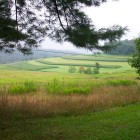
By Dr. Sally McMurry
The term “gray literature” well conveys the level of visibility for much work done at agencies like the Pennsylvania Historic Preservation Office. Historic Structures Reports, National Register nominations, exhibits, and drawings may have limited long-term public exposure even though they are often based on high-quality research and analysis. The Vernacular Architecture Forum (VAF) has recognized that these efforts often make exemplary contributions to our understanding of the built environment, and the organization honors such work through the Paul E. Buchanan Award. VAF spokesman Michael Chiarappa has characterized the award as a “testament to VAF’s commitment to civic engagement and the idea that broad participation in the study and understanding of vernacular landscapes provides an indispensible social good.” We are proud to announce that the Pennsylvania Agricultural History Project is the 2013 winner.
The VAF established the Buchanan Award in 1993 to honor Paul E. Buchanan, for many years the Director of Architectural Research at Colonial Williamsburg. Mr. Buchanan had a legendary reputation as a master interpreter and field observer; according to the VAF website, he “set the standard for architectural fieldwork in America” and mentored many who went on to make important contributions in the field. Past Buchanan Award winners have included field reports, exhibits, public programming, digital media productions, restoration projects, and Historic American Engineering Record (HAER) documentation. According to 2013 prize committee chair Michael Chiarappa, the Pennsylvania Agricultural History Project merited the award for providing “unprecedented guidance in studying Pennsylvania’s agricultural landscapes” and establishing “a framework for honoring and protecting them” through National Register listing.
The VAF was founded in 1980 to promote the study and preservation of ordinary buildings and landscapes from all times and places. The term “vernacular” is flexible and has come to encompass not only building types but methodologies as well. Vernacular architecture study emphasizes social and cultural context and commonly employs analytical tools from diverse disciplines – anthropology, gender studies, and the like. The organization’s membership comes from diverse backgrounds. Some work in academic institutions in disciplines like anthropology, folklore, geography, history, architectural history, and art history. Others staff (and often lead) museums, government agencies, and private firms. All share a passionate commitment to understanding and celebrating everyday landscapes, from colonial era folk housing to 20th-century suburban enclaves to industrial complexes. With over 600 members in the US and other countries, the VAF has been a major contributor to a fundamental rethinking of which buildings and landscapes are valuable (and why), and how to study them.
The Pennsylvania Agricultural History Project’s emphasis on typical agricultural buildings and landscapes is very much in keeping with the VAF’s founding principles. From the outset, the project framework treated Pennsylvania’s agricultural past broadly. For example, it acknowledged that diversified production prevailed until the mid-20th century and developed ways of portraying different kinds of diversified farming. As importantly, the conceptualization went beyond soils, topography, and markets to include social factors like land tenure, cultural repertoires, the gender organization of farm work, political factors, and labor systems. This approach accounts for ALL historic resources on a farm — it doesn’t stop with just the house and barn. Now we can better understand the tenant houses, “mansion” houses, multiple barn granaries, large machine sheds, and crop rotation patterns that typify the Central Valleys. We can see the role of cultural repertoires in making a three-bay “English” barn different from a three-bay German “ground” barn from the same period. We can appropriately interpret the Adams and Erie County fruit-belt areas where migrant workers were so important, and the Southeastern Pennsylvania region where much depended on women’s labor in home dairying. In turn, by enumerating specifically and comprehensively the buildings and landscape features typical for each region, the Registration Requirements allow users to assess a property’s eligibility quickly and accurately.
Finally, the Pennsylvania Agricultural History Project products are good examples of VAF’s commitment to public education and outreach. The entire corpus of work is accessible on the Web. This includes census maps and manuscripts, a Researcher’s Guide, narratives for each of the state’s sixteen historic agricultural regions, a bibliography, farm survey forms, and (my favorite) an Agricultural Field Guide to help users identify barns, outbuildings, and landscape features. We hope that this accessible, powerful, award-winning tool will result in more National Register nominations from Pennsylvania’s historic farming community.
Sally McMurry is Professor of History at Penn State University (University Park) and served as Principal Investigator for the Pennsylvania Agricultural History Project.
This post first appeared on August 21, 2013, in “Pennsylvania Historic Preservation” the Blog of the Pennsylvania Historic Preservation Office and is reprinted with the permission of the that office


